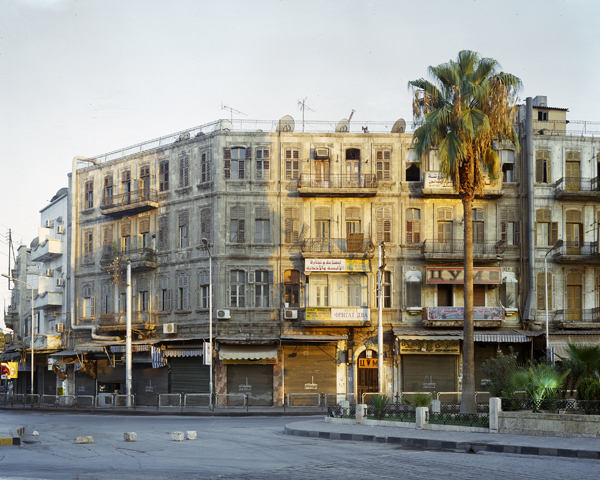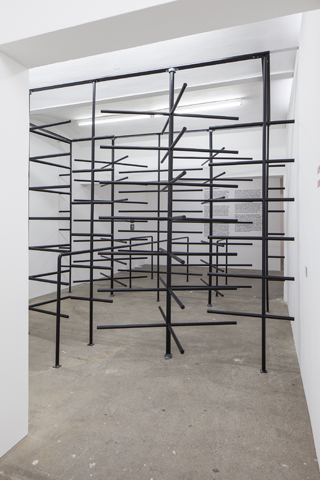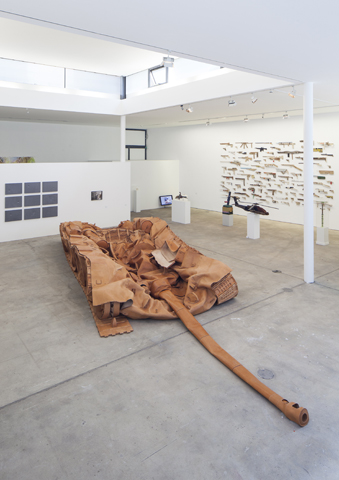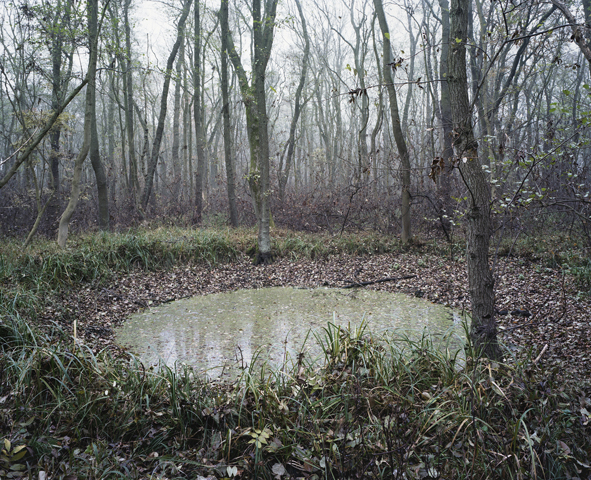Ouch, that hurt! War and Violence at KW Institute for Contemporary Art
- (first published on artlifemagazine.com)
- Jun 26, 2015
- 6 min read
Updated: Mar 25, 2020
(Berlin.) With Fire and Forget. On Violence, KW Institute for Contemporary Art, the cosy industrial venue in Berlin’s no-longer-that-hip “Mitte” district, aims to “[examine] current ideas of war and violence in contemporary art” (and you should definitely not insist on the “current” part, as there’s quite a lot of 20th Century art). KW - “Kunst Werke”, i.e. “Art Works” but also “Art Factory” - did not randomly add an Institute to its name; the gallery promises “scientific” research in art and society. Too easily an exhibition like this becomes biased, forcing one interpretation upon the visitor, to express what everybody’s supposed to say anyway: “Violence is bad, mmkay?”. Traces of this attitude can indeed be found in some exhibition related text material, but the art itself tackles the topic in all its ambivalence. With most exhibits the Janus face of human violence becomes apparent - at least if you allow the works to speak for themselves, and occasionally ignore the artist’s intention. Take Jota Castro’s walk-in steel cage, for instance. Imagine you had not read the title Guantanamo, and there are equal chances you’d think of imprisonment and torture, thus feeling uncomfortable in there – or raise your arms in triumph to mimic your favourite MMA fighter. It’s the attitude that makes the experience.
But let’s take a step back. To enter Fire and Forget, visitors need to pass a steel barrier like those used at sport stadiums and other mass events (Daniil Galkin, Tourniquet). The mental link evokes supressed human actions, danger and control, and a necessary reduction of liberty. And yet it’s useless, set up here all out of context. The spectacle takes place beyond the border, but the border is unguarded. Any wannabe art hooligan could smuggle in whatever weapon (s)he wanted. The object itself does not prevent violence, nor (fully) exert it. It does something to us, it invades our privacy, it forces us to movements we’d otherwise avoid, but to fulfil a purpose it would need a human guard to “pull the trigger”. In a way, this defensive fence is the same as a gun, nothing but an object, a sculpture, abstract lines and their interpretation.
Violence is part of our society and probably of humanity itself, a trait of life. We’d dare say without violence no emotion, and vice versa. From the violence of a mammal’s birth to the inevitable end that we try to blend out as far as possible, the fact cannot easily be disputed. There is joy in every excess, just not on the receiving end (or mostly not, but we’re no experts in SM). Perhaps it’s like so much in life: Love it from far and loathe it when near. Violent behaviour is banned from daily life, and society does not even distinguish much between corporal and speech acts any more (everybody’s so hurt by words today, and the violent persecution of words creates a climate of fear to say anything wrong). Professional boxing is fine, but two groups of football fans meeting in the woods is evil. On the other hand, unregulated eruptions of violence get more and more extreme, and warfare conventions are undermined on all sides.
What does it mean to prevent violence, is this even possible without resorting to - violence? On a wall around the corner, we read words ("artwords" on "artwars", so to say) by Barbara Kruger: “My folks are better than yours ... We’re good, you’re evil ... Our shit don’t stink ...”: justifications of violent (political) acts. But is not everybody who claims the monopoly on truth a narcissistic demagogue – right up to the artist denouncing that very rhetoric? Think of self-righteous parent groups proudly condemning video games and cartoons. At KW Institute, we may indulge in violent play ourselves with Hunter Jonakin’s Jeff Koons Must Die: A fully functional 3D shooter in which players/the audience interacting with the artwork shoot down the star’s most famous artworks. We loved it. (It’s better than that other art game you will find on the web and that’s called “Punch a Monet”.) It’s fun to destroy things, at least if your inner child is still alive and kicking. Of course, you could also just visit the virtual exhibition, and ignore the gun in your hands. But it being there... Apparently, Koons did not fight back with institutionalised violence, i.e. lawyers claiming the copyright to his works’ depictions. That’s a good thing.
Violence as a policy enforcer is an ever latent potential. Julian Roeder’s photograph Genoa 2001 shows a person dressed to protest standing alone on a street with a collection of brick missiles at his/her feet and reading - a plan of action? a pamphlet? a street map? The title refers to that year’s protests against a G8 Summit, but the work is a reminder that human violence is not necessarily impulsive and can be unleashed by choice. Take a break, and instructions maybe, then strike again. Here’s a parallel to Mircea Cantor’s Shoot with two soldiers “shooting” photographs of each other. Obviously, killing is only one part of their life.
Much later in the show, we are confronted with an amorphous mass, Julius von Bismarck’s group of life size police men and women hidden under armour, depersonalized in service to their masters. Counter violence, us against them, the state an enemy; or simply a stratagem known from non-human animals: the imposing appearance of power prevents violent eruptions of conflict.
Videos of Pipilotta Rist smashing car windows with a giant flower bat and smiling at police women, and Marina Abramovich and Ulan happy slapping each other’s face may be perceived as acts of liberation. And violence may be aimed at oneself: All legitimate doubts about his place in art history aside, Damian Hirst did some great stuff. Who remembers Hirst creating works like Do it (1996)? Back then in plain hype he instructed us how to shoot oneself with a gun. What sounds horrible is a witty idea: The occupation with violence leads away from the actual act. After watching this video you’d be much too scared to be left alive without a face, or paralysed; and the “only right way” to do it save - from above - looks much too ridiculous, not cool enough for any serious suicidalist. (This is art, but how’s reality? Only two years before the creation of this work, Kurt Cobain was “lucky” to succeed despite doing it all wrong. And a decade later, in 2008, an old friend and colleague of Hirst’s took the odd rope.)
War imagery is omnipresent at Fire and Forget. On Violence. The collection of arms spans from an inflatable leather tank to bullet holes on steel panels, an assortment of wooden guns and a toy fighter heli. The aesthetics not of death but of means to die, or to kill.
Drawing machines are nothing revolutionary today, and here’s one from Roy Brand, Ori Scialom and Keren Yeala Golan tattooing circles in a sandbox. We learn, this signifies the evolution of Israeli settlements since 1951, and like a general drawing battle plans it seems completely out of touch with reality. In the end it’s all wiped out, leaving nothing but desert, which seems a dangerous implication.
It’s probably safe to assume, that in Europe, there’s not only not a square metre left on which nobody ever set foot, but neither a place where nobody ever got killed. Some artists summon the past, such Henning Rogge with photos of bomb craters that have long become a part of the landscape (it somehow reminds of Taryn Simon’s crime scenes.) In a similar idea, Hair Sarkissian shows Execution Squares in Syrian cities. It’s a thin line between art and documentation. Historical private war photography throughout the exhibition is explicitly meant as non-art, but then there’s artist Luis Camnitzer’s Uruguayan torture series from 1983, documenting the actual effects.
Fire and Forget, we’re taught, is military lingo for a missile that will find its target without the operator seeing the results of his/her action nor being exposed to any danger him/herself. Drones would be its most extreme incarnation. Latest research suggests that the “forget” part is harder than expected; drone operators suffer not less from their job than old school marines. And it’s the same with this exhibition: apart from the literal meaning – artworks about the effects of violence, artworks that bring past violence back to light – visitors won’t forget immediately, either. We told you only about a fraction of artworks at KW Institute, go and see for yourself (if you dare). One artist we would have loved to see here is Jerome Zonder, whose tough to endure drawings raise the question, whether violent children copy violent adults, or if on the contrary violent adults are untamed children, but the brilliant young artist’s fame has not yet reached Berlin. However, three doors away from KW Institute, a commercial gallery shows woollen sculptures of Patricia Waller’s with much comic violence in a horror theme park. Maybe a new trend is born.
Oh yeah, and somehow we think they should have included Jessica Warboys too, only for her name.
Fire and Forget. On Violence, KW Institute for Contemporary Art, Berlin, 14 June-30 August 2015










Comments